Related Research Articles

The Concordat of Worms, also referred to as the Pactum Callixtinum or Pactum Calixtinum, was an agreement between the Catholic Church and the Holy Roman Empire which regulated the procedure for the appointment of bishops and abbots in the Empire. Signed on 23 September 1122 in the German city of Worms by Pope Callixtus II and Emperor Henry V, the agreement set an end to the Investiture Controversy, a conflict between state and church over the right to appoint religious office holders that had begun in the middle of the 11th century.

The Holy See, also called the See of Rome, Petrine See or Apostolic See, is the central governing body of the Catholic Church and the Vatican City State. It encompasses the office of the pope as the bishop of the Apostolic episcopal see of Rome and serves as the spiritual and administrative authority of the worldwide Catholic Church and the city-state. Under international law, the Holy See holds the status of a sovereign juridical entity.

Pope Eugene IV, born Gabriele Condulmer, was head of the Catholic Church and ruler of the Papal States from 11 March 1431 to his death, in February 1447. Condulmer was a Venetian, and a nephew of Pope Gregory XII. In 1431, he was elected pope.

The Lateran Treaty was one component of the Lateran Pacts of 1929, agreements between the Kingdom of Italy under Victor Emmanuel III and Benito Mussolini and the Holy See under Pope Pius XI to settle the long-standing Roman question. The treaty and associated pacts were named after the Lateran Palace where they were signed on 11 February 1929, and the Italian Parliament ratified them on 7 June 1929. The treaty recognised Vatican City as an independent state under the sovereignty of the Holy See. Fascist Italy also agreed to give the Catholic Church financial compensation for the loss of the Papal States. In 1948, the Lateran Treaty was recognized in the Constitution of Italy as regulating the relations between the Italian Republic and the Catholic Church. The treaty was significantly revised in 1984, ending the status of Catholicism as the sole state religion.

The Council of Florence is the seventeenth ecumenical council recognized by the Catholic Church, held between 1431 and 1449. It was covened in territories under the Holy Roman Empire. Italy became a venue of a Catholic ecumenical council after a gap of about 2 centuries. It was convoked as the Council of Basel by Pope Martin V shortly before his death in February 1431 and took place in the context of the Hussite Wars in Bohemia and the rise of the Ottoman Empire. At stake was the greater conflict between the conciliar movement and the principle of papal supremacy.
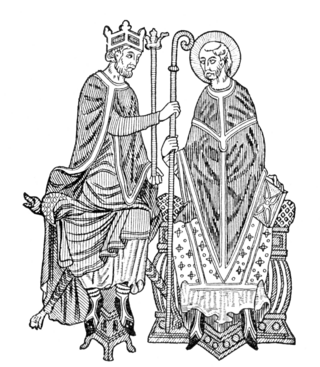
The Investiture Controversy or Investiture Contest was a conflict between the Church and the state in medieval Europe over the ability to choose and install bishops (investiture) and abbots of monasteries and the pope himself. A series of popes in the 11th and 12th centuries undercut the power of the Holy Roman Emperor and other European monarchies, and the controversy led to nearly 50 years of conflict.
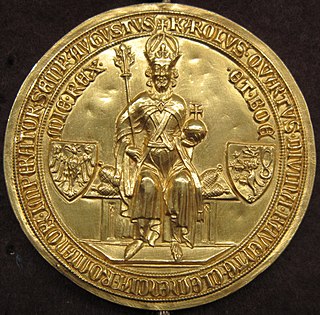
The Golden Bull of 1356 was a decree issued by the Imperial Diet at Nuremberg and Metz headed by the Emperor Charles IV which fixed, for a period of more than four hundred years, important aspects of the constitutional structure of the Holy Roman Empire. It was named the Golden Bull for the golden seal it carried.

Febronianism was a powerful movement within the Catholic Church in Germany, in the latter part of the 18th century, directed towards nationalising Catholicism, restricting the power of the papacy in favour of the episcopate, and reunion of dissident churches with the Catholic Church. Its thrust broadly corresponded to that of Gallicanism in France. Friedrich Lauchert describes Febronianism, in the Catholic Encyclopedia, as a politico-ecclesiastical system, ostensibly purposed to facilitate reconciliation of Protestant entities with the Catholic Church by curbing the Holy See's power.
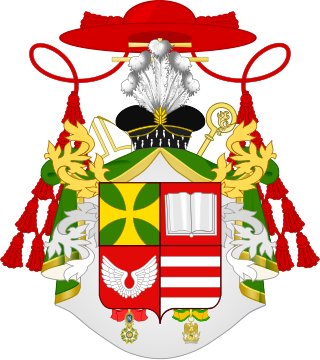
Giovanni Battista Caprara Montecuccoli was an Italian statesman and cardinal and archbishop of Milan from 1802 to 1810. As a papal diplomat he served in the embassies in Cologne, Lausanne, and Vienna. As Legate of Pius VII in France, he implemented the Concordat of 1801, and negotiated with the Emperor Napoleon over the matter of appointments to the restored hierarchy in France. He crowned Napoleon as King of Italy in Milan in 1805.
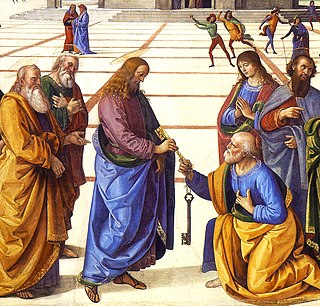
According to Roman Catholicism, the history of the papacy, the office held by the pope as head of the Catholic Church, spans from the time of Peter to the present day.

Juan Carvajal (Carvagial) was a Spanish Cardinal. Though he began his career as a lawyer and judge in the papal administration, he spent most of his active life travelling as a diplomat in Germany and eastern Europe, attempting to arrange a crusade against the Ottoman Turks. He was particularly active in Bohemia and Hungary, where he also employed his powers to fight the Hussites. He was a mainstay in trying to preserve the institution of the Papacy from the Conciliarism of the Council of Basel.

The papal election held from 4 to 7 September 1159 following the death of Pope Adrian IV resulted in the election of two rival popes. A majority of the cardinals elected Cardinal Rolando of Siena as Pope Alexander III, but a minority refused to recognize him and elected their own candidate, Ottaviano de Monticelli, who took the name Victor IV, creating a schism that lasted until 1178.
A treaty of the Holy See is called a Concordat. This is a list.
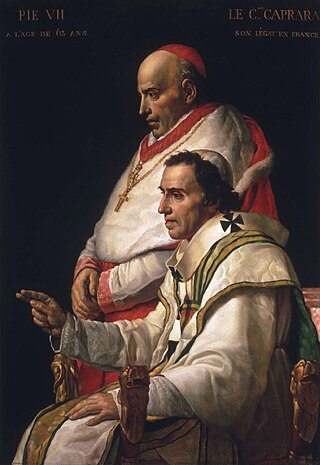
The relationship between Napoleon and the Catholic Church was an important aspect of his rule.
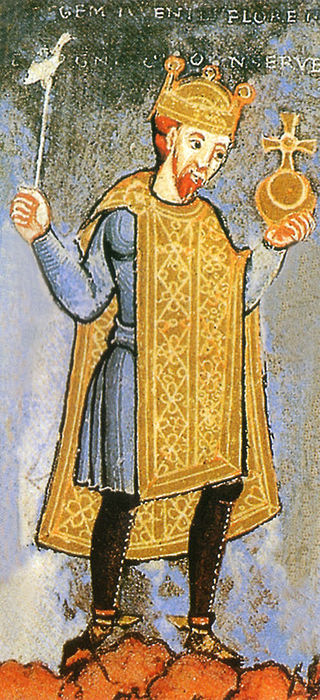
The history of the papacy from 1046 to 1216 was marked by conflict between popes and the Holy Roman Emperor, most prominently the Investiture Controversy, a dispute over who— pope or emperor— could appoint bishops within the Empire. Henry IV's Walk to Canossa in 1077 to meet Pope Gregory VII (1073–85), although not dispositive within the context of the larger dispute, has become legendary. Although the emperor renounced any right to lay investiture in the Concordat of Worms (1122), the issue would flare up again.
The Princes' Concordat was an agreement concluded in January 1447 between Pope Eugenius IV and the prince-electors of the Holy Roman Empire. It outlined generous concessions on the part of the Pope, particularly covering the appointment of Church positions, in exchange for the support of the German princes.

The papal nobility are the aristocracy of the Holy See, composed of persons holding titles bestowed by the Pope. From the Middle Ages into the nineteenth century, the papacy held direct temporal power in the Papal States, and many titles of papal nobility were derived from fiefs with territorial privileges attached. During this time, the Pope also bestowed ancient civic titles such as patrician. Today, the Pope still exercises authority to grant titles with territorial designations, although these are purely nominal and the privileges enjoyed by the holders pertain to styles of address and heraldry. Additionally, the Pope grants personal and familial titles that carry no territorial designation. Their titles being merely honorific, the modern papal nobility includes descendants of ancient Roman families as well as notable Catholics from many countries. All pontifical noble titles are within the personal gift of the pontiff, and are not recorded in the Official Acts of the Holy See.
The Concordat of 1161 was an agreement between the Kingdom of Hungary and the Papal States, signed by Géza II of Hungary and papal legate Pietro di Miso in late summer or early autumn 1161. The Hungarian monarch squeezed out significant church government concessions for himself in exchange for switching sides and pledging support for Pope Alexander III against the Ghibelline Antipope Victor IV.
The Concordat of 1169 was an agreement between the Kingdom of Hungary and the Papal States, signed by Stephen III of Hungary and Cardinal Manfred of Lavagna, the papal legate of Pope Alexander III in Veszprém or Esztergom in 1169.
From the time of Constantine I's conversion to Christianity in the 4th century, the question of the relationship between temporal and spiritual power was constant, causing a clash between the Church and the Empire. The decline of imperial power initially allowed the pope to assert greater independence. However, beginning in 962, the Holy Roman Emperor assumed control over papal elections and the appointment of bishops, reinforcing imperial authority over the Church.
References
- ↑ Creighton, Mandell (1882). A History of the Papacy During the Period of the Reformation. Vol. 2. Longmans, Green, and Company. pp. 282ff.
- ↑ Waugh, W.T. (2016). A History of Europe: From 1378 to 1494. Routledge. p. 318. ISBN 9781317217039.